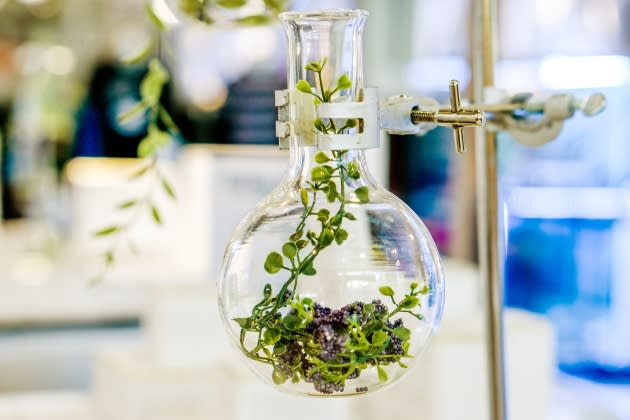L’Oréal Invests in Geno-led Venture for Sustainable Ingredients

PARIS — L’Oréal is picking up the pace of its quest for sustainable ingredients. The world’s largest beauty company said Monday that it has invested in the Geno-led initiative centered on developing, producing and commercializing biotechnology-based alternatives to key beauty product ingredients.
L’Oréal, which made its investment through BOLD, the group’s corporate venture fund, did not disclose terms of the investment.
More from WWD
The group joins Genomatica Inc., known as Geno, plus Unilever and Kao as a founding member of the initiative.
L’Oréal and Geno will roll out a technological platform in a bid to harness biotech’s power. The group will mix microorganism and industrial processes to ferment plant sugars into materials and ingredients, developing plant-based ingredients as alternatives to traditional ingredients. Those are to be incorporated into some L’Oréal products.
Geno is among the most the most powerful biotech start-ups, based in San Diego — a hotbed of biotech innovation, explained Barbara Lavernos, L’Oréal deputy chief executive officer in charge of research, innovation and technology.
Geno develops sustainable materials stemming from plant- or waste-based feedstocks, rather than fossil fuels. Its materials are used in products ranging from cosmetics, carpets, performance foods and drinks to home cleaners and apparel.
“They are both in innovation and are able to scale up,” said Lavernos, adding another key strength of Geno is that it can work on a whole portfolio of ingredients, rather than ingredients on an individual basis.
With L’Oréal, the venture’s findings will help contribute to making sustainable alternatives to various surfactants, which in cosmetics are used for effects such as cleansing, foaming, thickening and emulsifying.
“There are other molecules, [too],” Lavernos said. “We are working with them on different possibilities, different portfolios of ingredients.”
Discoveries from the initiative are meant to benefit the beauty industry at large and aid in reducing its environmental footprint.
It’s “coopetition,” where competitors join forces, rather than traditional “competition,” explained Lavernos. She said due to the environmental challenges planet Earth faces, it’s key that companies band together in the changeover to green sciences, using a large platform.
“With Geno, we are going to drive priorities together,” Lavernos said.
“One of the things we see that’s terrific about L’Oréal being a part of this is it’s sending what I call tangible market signals more broadly in that context of the opportunity around delivering more sustainable solutions for the ingredients and the materials that shape the world we live in,” said Christophe Schilling, CEO of Geno.
“In this case, [that is] very much specifically related to the types of beauty products that L’Oréal has,” he continued. “Having the number-one beauty [company] join into this initiative that we have and the types of solutions that we’re pushing forward to help in this broader materials transition is terrific.”
The Geno project is in a nascent phase. In June 2022, Unilever said it had teamed with Geno for a $120 million venture to commercialize and scale alternatives to palm oil and fossil fuel-derived ingredients. The stated aim of the project was to offer plant-based, sustainable and highly efficient alternatives to the home and personal care markets, which have a combined value of $625 billion.
Then in October 2022, Kao joined forces with Geno and Unilever.
“Clearly, partnerships are critical for us,” said Schilling, adding the sort of change-making Geno envisages can’t be done on its own.
L’Oréal’s investment in Geno syncs with the group’s drive to achieve its goals for 2030 under the L’Oréal for the Future program. That is built on respecting the boundaries of planet Earth and bolstering its sustainability and inclusion commitments, with the environmental focus on addressing the preservation of biodiversity, sustainable water management, circular use of resources and climate change.
By 2030, the company aims to have wholly eco-designed formulas that respect aquatic ecosystems and 95 percent of the company’s ingredients stemming from renewable plant-based resources or abundant minerals.
Today, 61 percent of L’Oréal’s formulas are biobased or derived from abundant minerals or circular processes, and 80 percent of its raw materials are biodegradable.
Green sciences — a combination of sustainable cultivation (think agronomy 2.0), extraction, green chemistry and biotechnology — “are essential to achieve our goals,” Lavernos said.
They also allow the group to find new ways to develop responsible innovations.
“Nature is powerful. We are discovering new active ingredients [and new materials],” she said. “We are introducing new innovations never before achieved by synthetic chemistry.”
Geno wants to reduce greenhouse gas emissions by hundreds of millions of tons. The company is scaling plant-based nylon with Aquafil and Asahi Kasei. It has linked up with Lululemon to bring the brand’s products plant-based materials.
L’Oréal has also long been a proponent of working with exterior partners, sometimes exclusively, in various research domains. Over the past 12 months, the group has forged approximately 20 partnerships in biotech, with focuses ranging from bacteria to microalgae and fungi.
“L’Oréal has created a unique ecosystem and has invested massively in biotech around the world,” Lavernos said.
Best of WWD
